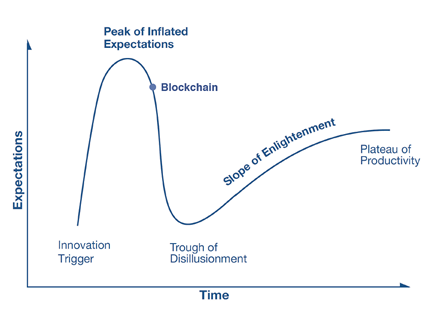Professor J. Leon Zhao is Chair Professor and Director of the Center on Global Internet Finance, College of Business, City University of Hong Kong. His research on information technology focuses on workflow technology and applications in knowledge distribution, e-learning, supply chain management, organizational performance management, and services computing.
Dr Ji Wu is Associate Research Fellow in the Department of Management Science, Sun Yat-sen University. His research interests are in the areas of social media marketing, and big data analysis in finance and organizations.
If you have been on Planet Earth over the last couple of years, you cannot fail to have heard of Bitcoin and its underlying technology, blockchain. Although the two concepts are often used interchangeably in the domain of cryptocurrency, in broad context Bitcoin and blockchain mean very different things. In this short article, let’s start with Bitcoin and then focus on blockchain surrounding the issue of trust, a concept that goes to the very core of all business activities.
From Bitcoin to blockchain
Bitcoin, an invention of cryptocurrency society, has grown into a mainstream business phenomenon over the past couple of years. In simple terms, Bitcoin is a type of digital money that is independent of any government or bank and can be used to exchange value among anyone who has access to the internet. Blockchain, on the other hand, is the supporting technology that enables Bitcoin (Nakamoto 2008). The terminology is not new. “Blockchain” was first used as early as 1976 in a patent by Ehrsam et al., denoting “message verification and transmission error detection by block chaining”.
Bitcoin is blockchain’s first killer app, but the underlying technology can be used to support many other types of business applications. According to Wikipedia, “a blockchain is a continuously growing list of blocks, which are linked and secured using cryptography. Each block contains a cryptographic hash of the previous block, a timestamp and transaction data. By design, a blockchain is inherently resistant to modification of the data.”
How does blockchain work?
Blockchain under Bitcoin is an open, distributed ledger that can efficiently record transactions between two parties. The main ideas behind blockchain technology are a distributed ledger structure and a consensus process based on proof-of-work. This structure allows a digital ledger of transactions to be created and shared between distributed computers on a network. The ledger may or may not be owned by one central authority but in the case of public blockchains can be viewed by all users on the network. When a user wants to add a transaction to the ledger, the transaction data is encrypted and proved by other computers on the network using cryptographic algorithms.
Once there is consensus among the majority of computers that the most recent small collection of transactions is valid, a new block of data is added to the chain and shared through the network of associated nodes. A distributed blockchain structure has the potential to allow companies and individuals making transactions to cut out the traditional intermediaries, thus reducing cost of transactions and the time lapse of working through third parties. Moreover, due to the consensus process based on proof-of-work, transactions based on blockchain are secure, trustable, auditable, and immutable. Recently, more consensus mechanisms have been developed such as proof-of-stake and proof-of-importance amongst others.
Public vs private blockchains
Blockchain systems can be broadly categorized into two modes of operation: public and private. As the names suggest, public blockchains allow anybody to use them, and Bitcoin is a case in point. Private blockchains, on the other hand, are created and accessed by a closed group of known participants that work together, perhaps in a particular industry or supply chain. In addition, blockchains can belong to a business alliance, commonly referred to as an alliance blockchain or consortium blockchain, essentially a collection of private blockchains that are governed by multiple institutions.
Since 2015, many business organizations have invested huge amounts of money to develop blockchain applications in contexts where trust is the utmost underlying business concern. Ethereum, Hyperledger Fabric, and R3 Corda are three well-known blockchain systems that have been developed to support financial and other types of business applications that require high levels of trust and better business efficiency. Table 1 gives a comparison of these three systems in terms of platform, developer, mode of operation, consensus mechanism, smart contracts, and currency. It should be noted that the extent to which R3 Corda exhibits blockchain-like features has been questioned by some researchers (Valenta and Sandner 2017).
Ethereum is a software platform that enables developers to create markets, store registries of debts or promises, move funds in accordance with smart contracts, i.e., programmed instructions (such as a will or a futures contract) without a middleman. This platform was developed by the Ethereum Foundation, a Swiss non-profit, with contributions across the globe. Ethereum allows user data to remain private and applications to be decentralized.
Hyperledger Fabric is a software platform extending one of the Hyperledger projects hosted by The Linux Foundation. Hyperledger Fabric features a modular architecture that allows components, such as consensus and membership services, to be integrated into existing business systems. Hyperledger Fabric is a blockchain framework implementation and leverages container technology to host smart contracts that automate the application logic. Hyperledger Fabric was initially contributed by Digital Asset and IBM.
R3 Corda is an open-source platform for handling complex transactions with a high level of security. The R3 consortium consists of over 70 large financial institutions that are jointly developing distributed ledger financial systems. Although it is inspired by blockchain technology and is expected to share many of its benefits, the aim of Corda is to provide a platform with common services going well beyond basic blockchain features such as cross-border payments and clearance to its network participants.
| Table 1: Comparison of popular blockchain platforms |
| Characteristic |
Ethereum |
Hyperledger Fabric |
R3 Corda |
| Description of platform |
- Generic blockchain platform |
- Modular blockchain platform |
- Specialized distributed ledger platform for financial industry |
| Governance |
- Ethereum developers |
- Linux Foundation |
- R3 |
| Mode of operation |
- Permissionless, public or private |
- Permissioned, private |
- Permissioned, private |
| Consensus |
- Mining based on proof-of-work (PoW)
- Ledger level |
- Broad understanding of consensus that allows multiple approaches
- Transaction level |
- Specific understanding of consensus (i.e., notary nodes)
- Transaction level |
| Smart contracts |
- Smart contract code (e.g., Solidity) |
- Smart contract code (e.g., Go, Java) |
- Smart contract code (e.g., Kotlin, Java)
- Smart legal contract (legal prose) |
| Currency |
- Ether
- Token via smart contract |
- None
- Currency and token via chaincode |
- None |
Demystifying the blockchain hype
The Gartner Hype Cycle for 2017 illustrates that blockchain has just moved beyond the peak of inflated expectations. In this stage, the bubble is bursting, and the truth about the practical potential of blockchain is coming out. This stage is a good time to sort out the fakes and seize the value. As in stock cycles, this is the time to get your cash ready and wait for the time to jump in. However, as new innovations require early investments, companies need to train their technical people at this stage so that they will start sharpening their business strategies and get ready to adopt blockchain technologies. This chart is merely a best guess by the partners of Gartner Inc., a well-known consulting firm, but nevertheless shows approximately at what stage blockchain is along its lifecycle of development.
Gartner Hype Cycle 2017
Photo courtesy of ©Gartner, Inc.
Gartner, Press Release, August 15, 2017, “Gartner Identifies Three Megatrends That Will Drive Digital Business Into the Next Decade”, https://www.gartner.com/newsroom/id/3784363
Gartner does not endorse any vendor, product or service depicted in its research publications, and does not advise technology users to select only those vendors with the highest ratings or other designation. Gartner research publications consist of the opinions of Gartner's research organization and should not be construed as statements of fact. Gartner disclaims all warranties, expressed or implied, with respect to this research, including any warranties of merchantability or fitness for a particular purpose.
Blockchain or conventional database?
When should blockchain be used in place of conventional databases? Many people find it difficult to distinguish hype from real possibilities. Table 2 compares the basic features of the two information technologies. Both have security features: conventional databases rely on firewalls, while blockchains depend on dual-key encryption. Dual-key has the advantage of record-level granularity of security but suffers from low throughput in information access. That is one of the reasons why blockchain only became practical recently with the introduction of today’s fast software and hardware infrastructure. Conventional databases are preferred when high throughput is a critical requirement in low speed environments. If firewall security is sufficient, it is an indication that blockchain might not be necessary.
Conventional databases do not support consensus mechanisms as they are usually managed by a central authority. Conversely, public blockchains usually support some kinds of consensus mechanism since they tend to rely on collective decisions to function. If the given business application does not need any consensus mechanism, the use of blockchains must be justified for some other reason such as to combat internal frauds.
Both conventional databases and blockchains may be subject to internal and external fraud activities. Cases of stocks falling due to fraud with conventional databases have been widely reported in the media. Blockchains on the other hand are designed with the DNA of fraud prevention. So, if prevention of fraud is the dominant factor of company concern, and issues of cost and efficiency are secondary, blockchains might be a good choice.
| Table 2: Comparison between conventional databases and blockchains |
|
Conventional databases |
Blockchains |
| Firewalls |
Yes |
No |
| Dual-key encryption |
No |
Yes |
| Consensus mechanism |
No |
Yes |
| Vulnerable to frauds |
More |
Less |
| Open organizations |
No |
Yes |
| Data duplication |
Small |
Great |
| Automatic rules |
Triggers |
Smart contracts |
Blockchain was originally developed to support distributed autonomous organizations such as Bitcoin, that do not depend on a central authority to operate. The new technology is therefore a natural choice for organizations where central authority is relatively weak such as the United Nations or the Red Cross. Blockchains can, however, also be used under a strong central authority such as a central bank, where they may mitigate against organizational chaos during institutional transitions such as mergers or acquisitions.
One of the weaknesses of blockchain is the significant data duplication needed to support security and consensus. While fast computing and networking make data duplication workable in highly incentivized environments such as Bitcoin, in other contexts such as healthcare, too much data duplication might be a show stopper. Bitcoin’s success might partly be attributed to its very simple data structure and the relatively small amounts of data used.
Smart contracts
| What smart contracts can do |
| Financial services |
Trade clearing and settlement |
Manages approval workflows between counterparties, calculates trade settlement amounts, and transfers funds automatically |
| Coupon payments |
Automatically calculates and pays periodic coupon payments and returns principal upon bond expiration |
| Insurance claim processing |
Performs error checking, routing and approval workflows, and calculates payout based on the type of claim and underlying policy |
| Micro-insurance |
Calculates and transfers micropayments based on usage data from an Internet of Things-enabled device (example: pay-as-you-go automotive insurance) |
| Life sciences and healthcare |
Electronic medical records |
Provides transfer and/or access to medical health records upon multi-signature approvals between patients and providers |
| Population health data access |
Grants health researchers access to certain personal health information; micropayments are automatically transferred to the patient for participation |
| Personal health tracking |
Tracks patients' health-related actions through IoT devices and automatically generates rewards based on specific milestones |
| Technology, media, and telecom |
Royalty distribution |
Calculates and distributes royalty payments to artists and other associated parties according to the contract |
| Energy and resources |
Autonomous electric vehicle charging stations |
Processes a deposit, enables the charging station, and returns remaining funds when complete |
| Public sector |
Record-keeping |
Updates private company share registries and capitalization table records, and distributes shareholder communications |
| Cross-industry |
Supply chain and trade finance documentation |
Transfers payments upon multi-signature approval for letters of credit and issues port payments upon custody change for bills of lading |
| Product provenance and history |
Facilitates chain of custody process for products in the supply chain where the party in custody is able to log evidence about the product |
| Peer-to-peer transacting |
Matches parties and transfers payments automatically for various peer-to-peer applications: lending, insurance, energy credits, etc. |
| Voting |
Validates voter criteria, logs vote to the blockchain, and initiates specific actions as a result of the majority vote |
John Ream, Yang Chu, and David Schatsky, Upgrading blockchains: Smart contract use cases in industry, Deloitte Insights, June 8, 2016
To automate office work, both conventional databases and blockchains have developed internal mechanisms to model and execute rule-based business procedures. In database systems, these mechanisms are called triggers, and in blockchain systems, they are smart contracts. The latter are programmes that execute business procedures set up by their creators. They were first described by computer scientist and cryptographer Nick Szabo in 1993 as “digital vending machines”. Nowadays it is clear that smart contracts have wide ranging potential, and may accept input in the form of cryptocurrency, transfer payment or other data and will execute pre-configured commands as output. The trend in smart contracts is to implement more complex business procedures than triggers can model and execute, as demonstrated on platforms such as Ethereum. Smart contracts may be used in a number of sectors such as accountancy, law, healthcare, media, etc.
Blockchain in China
As blockchain moves beyond the peak of inflated expectation, many industrial and academic forums have been held in China on the development of the technology. At the end of 2017, the China Blockchain Technology and Industrial Development Forum was hosted in Guangzhou by the Ministry of Industry and Information Technology. This forum aims to develop standards of blockchain technology and to facilitate the advance of the technology into different industries. Also near the end of 2017, an academic forum on blockchain was hosted by the Center on Blockchain Innovation at the City University of Hong Kong Chengdu Research Institute, which attracted scholars from various disciplines, including computer science, software engineering, management information systems, economics, public administration, and information science. The forum discussed both implementation and application of blockchain technology.
Companies in China have begun to test blockchain technology in their industries. Many blockchain infrastructure providers have also emerged, such as BCOS, Onchain, and Ontology Zero. These providers offer services for companies to develop various blockchain applications based on their infrastructure by using various programming languages. Most recently, the BAT companies (Baidu, Alibaba, Tencent) have announced cloud services which will make blockchain applications easier to develop and implement.
The end of fake goods?
Alibaba and JD.com have started tackling China’s fake goods problem with blockchain by giving luxury goods, from hard alcohol to Louis Vuitton bags, an electronic passport, a unique QR code to record product lifecycles from source to destination.
“Whether to guarantee safety of food or authenticity of luxury products, consumers want transparency and traceability to be sure they’re eating safely, and not being duped with counterfeits,” says Haibo Sun, head of blockchain research and development at JD.com.
Blockchain will make the cost of counterfeiting too high to bear since generating an authentic lifecycle of each fake product is difficult. Although it will take many years to transform all businesses with blockchains, the journey has already begun, starting with some special applications such as fighting counterfeit goods.
Blockchain management
A leading China automaker Wanxiang Group, located in Shanghai, is now running its supply chain over blockchain technology. Auto manufacturers are integrated with suppliers producing fast, trustworthy, and transparent transactions. Wanxiang is looking to work with financial institutions to provide financial solutions for small and medium-sized suppliers. And the use of blockchain is not limited to manufacturing. Recently, Tsinghua University has teamed up with Walmart and IBM to digitally track the movement of Chinese pork from source to customer.
Governments at multiple levels in China are also striving to use blockchain technology to improve public services. Factom is working on a number of projects to help local government develop data infrastructure for smart cities and integrate blockchain technology with electronic data services to enhance integrity in government information management. When blockchain is used internally to replace conventional databases, governments can better manage physical and digital assets, record internal transactions among different functions, and verify identities for public services.
The trust machine
In October 2015, The Economist magazine famously dubbed blockchain “the trust machine”. The technology behind Bitcoin could transform how the economy works. The article explained how blockchain has the potential to deal with the trust problem in the business world in the absence of government or other central authorities such as a bank. Some commentators believe that this article helped propel Bitcoin onto the main stage of business worldwide.
Nowadays, blockchain is attracting serious support in China. In February 2018, People’s Daily used a whole page to promote blockchain and the digital economy. It is quite unusual for a national newspaper to promote the adoption of a specific technology, indicating that blockchain is now a national strategy for China that will permeate all sectors and all enterprises. As such, the business community has been alerted to pay attention to blockchain adoption strategies. It is not exaggerating to say that blockchain will reshape many aspects of society in the years to come, hopefully towards a fairer and more efficient society.
While new technologies represent big opportunities for business innovation and market expansion, they also come with significant risks, particularly if a company does not apply blockchain properly. Consequently, risk management is a must. We give some simple words of advice for blockchain adoption. First, a company should begin prototyping with projects that have high potential benefits. Never go all-in unless you have no other alternative. Second, demand that blockchain projects rake in benefits continuously along the way, even though benefits may not always be measurable in dollars.
The Economist
© The Economist Newspaper Limited, London (October 31st 2015)
Recent blockchain developments in China
| 2017 |
|
| March |
Alibaba in partnership with PwC releases a blockchain based supply-chain tracking system to trace the process of food delivery |
| April |
Wuzhen Institute publishes a white paper on the development of China’s blockchain industry
Tencent releases a white paper detailing a suite of blockchain services currently in development including the Trust SQL platform |
| July |
The National Committee of Experts on Internet Financial Security Technology publishes blockchain compliance guidelines
WeBank, Wanxiang Blockchain and Juzix release the Blockchain Open Source platform providing application services for enterprises |
| August |
Alibaba in cooperation with the Chinese government launches the first blockchain medical application in China |
| December |
China files more than half the world's blockchain patents in 2017 (225 out of 406 patents worldwide) according to Thomson Reuters from the World Intellectual Property Organization database |
Based on https://blog.gatecoin.com/a-glimpse-at-chinas-blockchain-ecosystem-638c3d9988d2
References:
- Ehrsam, W. F., Meyer, C. H. W., Smith, J. L., & Tuchman, W. L. (1976). U.S. Patent No. 4074066. Washington, DC: U.S. Patent and Trademark Office. “Message verification and transmission error detection by block chaining”
- Nakamoto, S. (2008, October 31). Bitcoin: A peer-to-peer electronic cash system. Retrieved from www.bitcoin.org
- Berkeley, J. (2015, October 31). The trust machine, the promise of the blockchain. The Economist.
- Valenta, M. & Sandner, P. (2017). Comparison of Ethereum, Hyperledger Fabric and Corda. Germany: Frankfurt School Blockchain Center.






